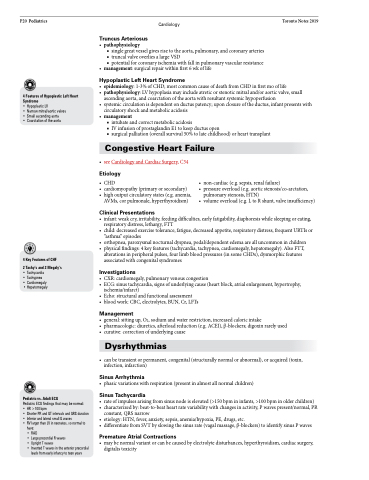Page 1054 - TNFlipTest
P. 1054
P20 Pediatrics
Cardiology
Toronto Notes 2019
4 Features of Hypoplastic Left Heart Syndrome
• Hypoplastic LV
• Narrow mitral/aortic valves
• Small ascending aorta • Coarctation of the aorta
Truncus Arteriosus
• pathophysiology
■ single great vessel gives rise to the aorta, pulmonary, and coronary arteries ■ truncal valve overlies a large VSD
■ potential for coronary ischemia with fall in pulmonary vascular resistance
• management:surgicalrepairwithinfirst6wkoflife
Hypoplastic Left Heart Syndrome
• epidemiology:1-3%ofCHD;mostcommoncauseofdeathfromCHDinfirstmooflife
• pathophysiology:LVhypoplasiamayincludeatreticorstenoticmitraland/oraorticvalve,small
ascending aorta, and coarctation of the aorta with resultant systemic hypoperfusion
• systemiccirculationisdependentonductuspatency;uponclosureoftheductus,infantpresentswith
circulatory shock and metabolic acidosis • management
■ intubate and correct metabolic acidosis
■ IV infusion of prostaglandin E1 to keep ductus open
■ surgical palliation (overall survival 50% to late childhood) or heart transplant
Congestive Heart Failure
• seeCardiologyandCardiacSurgery,C34 Etiology
• CHD
• cardiomyopathy(primaryorsecondary)
• highoutputcirculatorystates(e.g.anemia,
AVMs,corpulmonale,hyperthyroidism)
Clinical Presentations
• non-cardiac(e.g.sepsis,renalfailure)
• pressureoverload(e.g.aorticstenosis/co-arctation,
pulmonarystenosis,HTN)
• volumeoverload(e.g.LtoRshunt,valveinsufficiency)
4 Key Features of CHF
2 Tachy’s and 2 Megaly’s
• Tachycardia • Tachypnea
• Cardiomegaly
• Hepatomegaly
• infant:weakcry,irritability,feedingdifficulties,earlyfatigability,diaphoresiswhilesleepingoreating, respiratory distress, lethargy, FTT
• child:decreasedexercisetolerance,fatigue,decreasedappetite,respiratorydistress,frequentURTIsor “asthma” episodes
• orthopnea,paroxysmalnocturnaldyspnea,pedal/dependentedemaarealluncommoninchildren
• physicalfindings:4keyfeatures(tachycardia,tachypnea,cardiomegaly,hepatomegaly).AlsoFTT, alterations in peripheral pulses, four limb blood pressures (in some CHDs), dysmorphic features
associated with congenital syndromes
Investigations
• CXR:cardiomegaly,pulmonaryvenouscongestion
• ECG:sinustachycardia,signsofunderlyingcause(heartblock,atrialenlargement,hypertrophy,
ischemia/infarct)
• Echo:structuralandfunctionalassessment
• bloodwork:CBC,electrolytes,BUN,Cr,LFTs
Management
• general:sittingup,O2,sodiumandwaterrestriction,increasedcaloricintake
• pharmacologic:diuretics,afterloadreduction(e.g.ACEI),β-blockers;digoxinrarelyused • curative:correctionofunderlyingcause
Dysrhythmias
• canbetransientorpermanent,congenital(structurallynormalorabnormal),oracquired(toxin, infection, infarction)
Sinus Arrhythmia
• phasicvariationswithrespiration(presentinalmostallnormalchildren)
Sinus Tachycardia
• rateofimpulsesarisingfromsinusnodeiselevated(>150bpmininfants,>100bpminolderchildren)
• characterizedby:beat-to-beatheartratevariabilitywithchangesinactivity,Pwavespresent/normal,PR
constant, QRS narrow
• etiology: HTN, fever, anxiety, sepsis, anemia/hypoxia, PE, drugs, etc.
• differentiatefromSVTbyslowingthesinusrate(vagalmassage,β-blockers)toidentifysinusPwaves
Premature Atrial Contractions
• maybenormalvariantorcanbecausedbyelectrolytedisturbances,hyperthyroidism,cardiacsurgery, digitalis toxicity
Pediatric vs. Adult ECG
Pediatric ECG findings that may be normal:
• HR>100bpm
• Shorter PR and QT intervals and QRS duration
• InferiorandlateralsmallQwaves
• RVlargerthanLVinneonates,sonormalto
have:
• RAD
• LargeprecordialRwaves
• Upright T waves
• InvertedTwavesintheanteriorprecordial
leads from early infancy to teen years


